When embarking on a weight-loss journey, beginners can benefit from a variety of workouts, but certain options are particularly suitable for those new to exercise. These workouts can enhance progress in the gym, bolster strength, increase lean muscle mass, and improve fat-burning efficiency. To support beginners in their fitness endeavors, here are five perfect weight-loss workouts that seamlessly integrate into any routine.
For beginners, it's advisable to focus on the basics. Choose simpler exercises such as goblet squats, dumbbell lunges, various dumbbell press variations, mountain climbers, and planks, along with less intense cardio intervals. Prioritize maintaining proper form and aim for moderate reps within your sets. By achieving small victories each day and maintaining consistency, you can steadily build confidence and progress towards your weight-loss goals. This approach forms a potent combination for success in your fitness journey.
Here are five perfect weight-loss workouts for beginners, curated following my guidelines. These workouts feature simple yet effective exercises that can be easily progressed to more challenging variations as you gain experience in the gym. Forget about sticking to specific days of the week or restarting your training week every Sunday or Monday. Simply complete these workouts in order, take rest days as needed, and repeat these five workouts four to six times. Combine this routine with hydration, a balanced diet, and adequate recovery, and you'll be well on your way to achieving your weight-loss goals!
Continue reading for the best weight-loss workouts for beginners.
Workout #1: Upper Push and Lower Pull Strength
The optimal weight-loss workouts for beginners start with a focus on strength training. Strength workouts require readiness and concentration as they expend more energy and necessitate precise technique. In this session, you'll target both upper and lower body areas, emphasizing presses to shape your chest, shoulders, and triceps, while also engaging in exercises to strengthen your glutes and hamstrings. Incorporating a touch of abdominal work ensures a comprehensive inaugural workout.
1) 1-1-2 Incline Dumbbell Chest Press
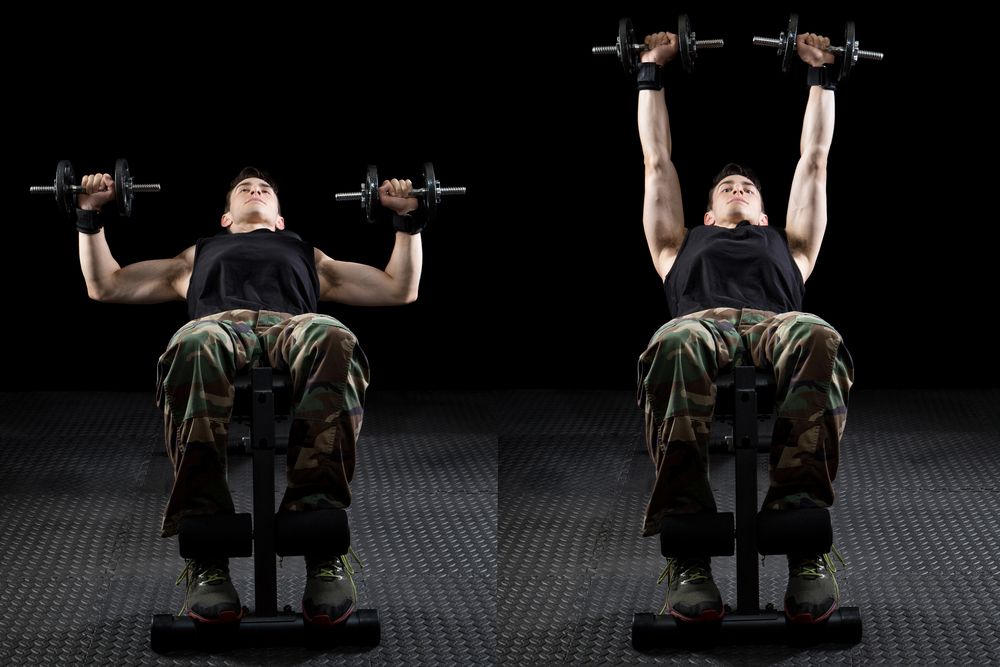
The inclined dumbbell chest press is a highly effective exercise for targeting the major anterior muscle groups of your upper body, including the chest, deltoids, triceps, and forearms. Incorporating the 1-1-2 concept, this exercise combines the stability and coordination benefits of unilateral movements with the strength and muscle-building qualities of bilateral exercises, making it a formidable choice for fat burning.
To begin, securely position yourself on an inclined flat bench. Lift the dumbbells above your chest and shoulders with your arms fully extended. Initiate the movement by performing a single-arm incline chest press with your right arm, ensuring controlled descent and powerful pressing action. Follow this with the left arm, maintaining control throughout. Then, seamlessly transition into a regular incline chest press, engaging both arms simultaneously to press the dumbbells upwards.
Completing this sequence constitutes one repetition. Aim to perform three sets of four to six repetitions, with rest intervals of 75 seconds between sets. This structured approach optimizes muscle engagement and progression while allowing adequate recovery for maximum effectiveness.
2) Dumbbell Glute Bridges
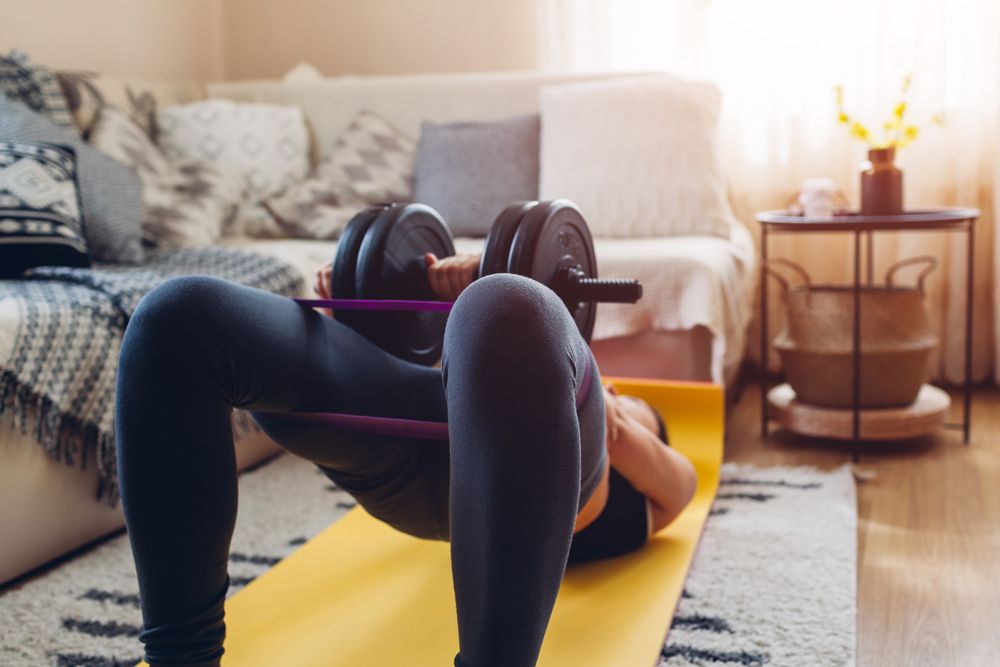
Having well-developed glutes offers more benefits than just boosting your metabolism. As one of the largest muscle groups in your body, giving attention to your glutes is essential. Additionally, strong glutes contribute significantly to enhancing performance in exercises like deadlifts, squats, lunges, Romanian deadlifts (RDLs), and various abdominal exercises.
To begin, lie on your back with your knees bent and feet flat on the ground, shoulder-width apart. Ensure your shins are vertical and your ankles and knees are aligned. Engage your abdominal muscles by slightly tilting your pelvis towards your chin. Push through your heels, lifting your hips off the ground while squeezing your glutes at the top of the movement.
Complete three sets of 18 to 20 repetitions, with rest intervals of 75 seconds between sets. This regimen targets and strengthens your glutes effectively while allowing sufficient recovery time for optimal performance.
3) Side Planks with Leg Lifts
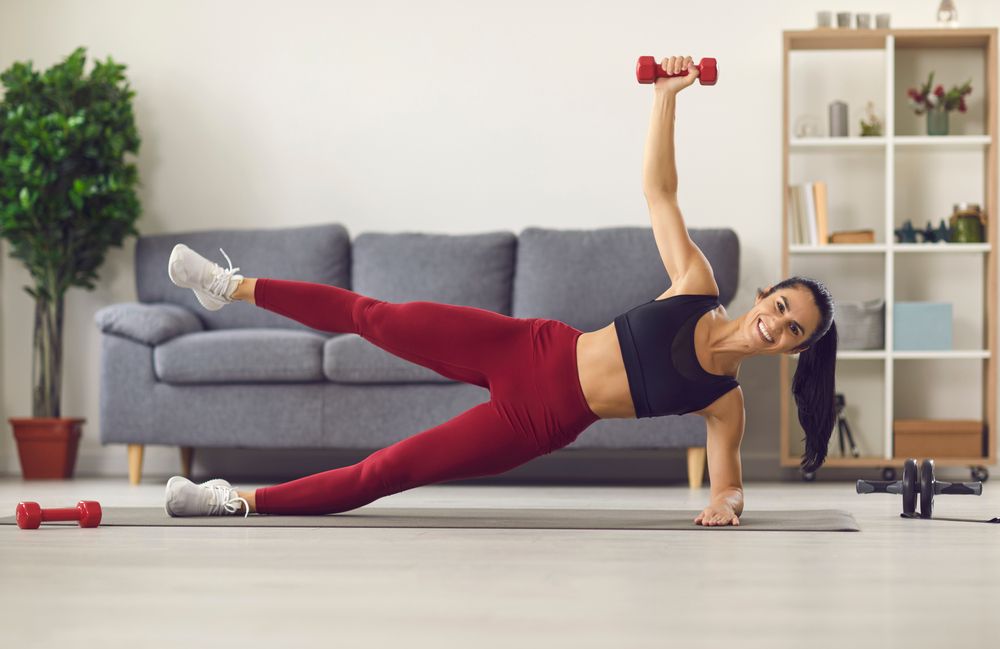
This variation of the side plank focuses on engaging your obliques and abs while maintaining the emphasis on training your lateral glute muscles. If raising your leg feels too challenging initially, begin by lifting it to a comfortable height and work on gradually increasing the elevation with each repetition.
To perform this exercise, start by assuming a side plank position with your elbow positioned directly under your shoulder, ensuring your hips are lifted to create a straight line with your body. Lift your upper leg directly upward, activating your hip muscles, and hold briefly before lowering it back down. Switch sides and repeat the movement. Aim to complete three sets of 15 to 20 repetitions per side, resting for 60 seconds between sets.
Workout #2: Lower Push and Upper Pull Strength
During your second workout, you'll allow your pressing and hinge muscles to rest while concentrating on fortifying your lats, upper back, and quadriceps. Squats are matched with rows, and your core workout will target your rectus abdominis, commonly known as the six-pack abs! Stay mentally and physically engaged, as this session can present a significant challenge.
1) One-and-a-Half Goblet Squats
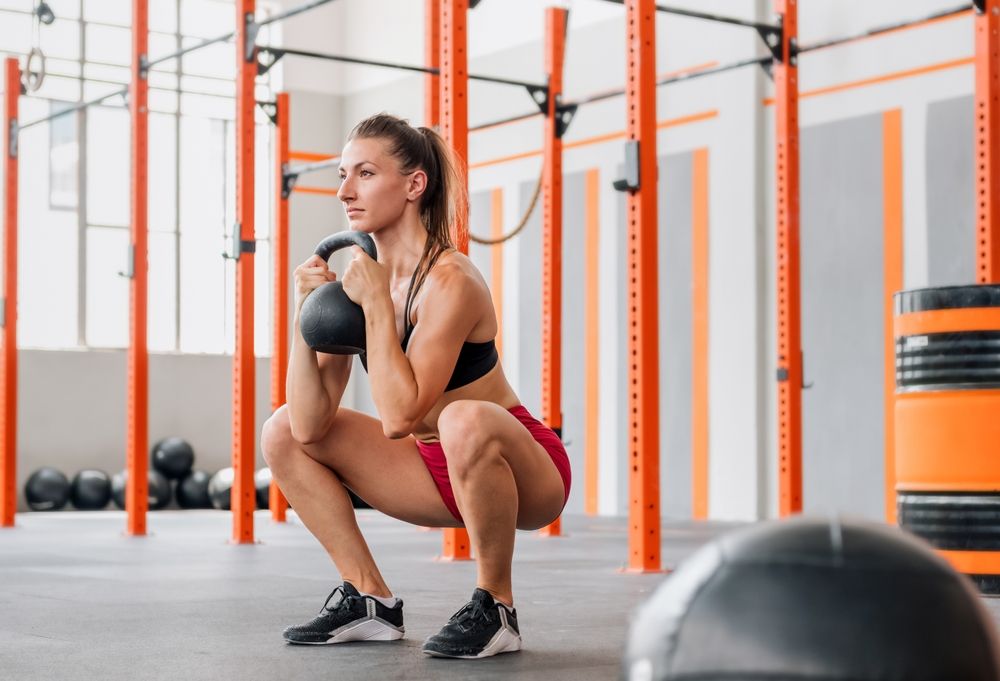
The one-and-a-half goblet squat is all about time under tension, dictating the pace. Engage your core and feel the burn in your quads as you execute a full-depth squat, rise halfway, and descend again for one powerful repetition.
To perform this exercise, grasp a kettlebell or dumbbell close to your chest, maintaining a shoulder-width stance. Lower your body into a squat position, ensuring your chest remains upright and your core is activated as you bend your knees and push your hips back. Descend until your thighs are parallel to the ground or slightly lower. Rise halfway, then descend back into the squat position before standing up fully to complete one repetition. Aim for three sets of six to 12 reps with a 75-second rest period between sets.
2) Chest-Supported Dumbbell Rows

By providing support to your upper body, you can focus on fully elongating and contracting the lat muscles during rows. Chest-supported rows are tailored to target the lats while placing significant emphasis on the mid and upper back muscles. These compound movements prove highly effective in engaging multiple muscle groups simultaneously, elevating your metabolism to new heights.
To perform chest-supported dumbbell rows, begin by setting up a bench at a low incline and positioning dumbbells beside it. Lie face down on the bench with your chest against the incline and ensure your feet are firmly planted on the ground. Grasp a dumbbell in each hand with a neutral grip, allowing your arms to hang straight down. Engage your core and retract your shoulder blades as you pull the dumbbells towards your ribcage, keeping your elbows close to your body. Squeeze your shoulder blades together at the top of the movement, then slowly lower the dumbbells back to the starting position. Aim for three sets of eight to 12 repetitions with a 75-second rest interval between sets.
3) Reaching Forearm Planks
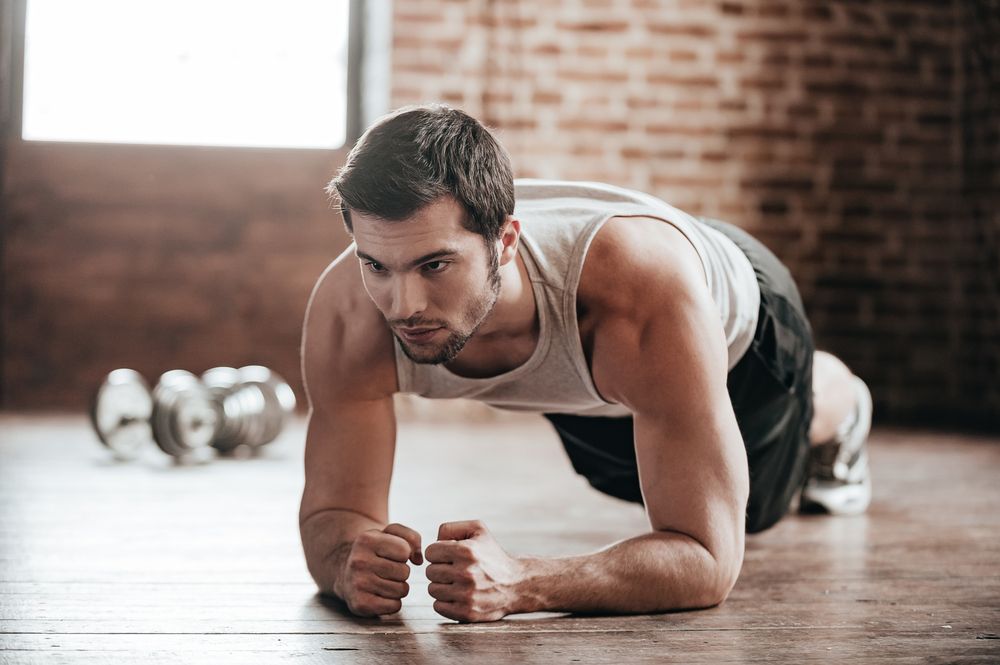
Incorporating a reach into forearm planks elevates the intensity (and instability) of this abdominal exercise. You'll concentrate on tightening your core (both abs and glutes) as you alternate reaching forward with your arms and tapping a kettlebell or dumbbell.
To begin, assume a plank position on your forearms, ensuring your elbows are positioned directly under your shoulders and your body forms a straight line from your head to your heels. Engage your core muscles to maintain stability as you lift your right arm off the ground and extend it straight forward, tapping a dumbbell or kettlebell. Hold this position briefly before lowering your arm back down. Repeat the movement with your left arm, extending it forward and holding it before returning to the starting position. Aim for three sets of five to 10 repetitions per side, resting for 60 seconds between sets.
Workout #3: Full-Body Muscle Building
Following the weight-loss workouts for beginners, we move on to a regimen focused on total-body muscle building. This routine entails incorporating more bodybuilding-style exercises to target smaller muscle groups and promote lean definition. Expect an increase in volume and shorter rest periods, as this workout intensifies, so prepare yourself accordingly!
1) Dumbbell Skull Crushers

Emphasizing high reps, short rest periods, and controlled movements will sculpt your triceps into a lean and defined shape. As a side note, you'll superset these exercises with seated leg extensions for a time-efficient workout.
To execute dumbbell skull crushers, start by lying down on a flat bench with a dumbbell in each hand. Extend your arms above your chest with palms facing each other and elbows slightly bent. Lower the dumbbells toward your ears by flexing your elbows, ensuring they remain pointed toward the ceiling while keeping your upper arms stable. Lower until the dumbbells reach beside your ears or slightly below, feeling the stretch in your triceps. Pause briefly, then extend your arms by straightening your elbows and contracting your triceps at the top. Aim for three sets of 12 to 20 repetitions with a 60-second rest period between sets.
2) Seated Leg Extensions

Isolation lifts serve as excellent options for building lean muscle, especially after engaging in compound exercises earlier in the week or during the training session. Seated leg extensions offer a comfortable (and sometimes uncomfortable if executed properly) means to target your quadriceps.
To begin, sit on a leg extension machine with your back against the backrest and your feet securely placed on the footpads. Exhale as you raise your legs, straightening your knees to lift the weight until your legs are fully extended. Hold the contraction briefly at the top, feeling the tension in your quadriceps. Inhale as you slowly lower the weight in a controlled manner, returning to the starting position. Aim for three sets of 12 to 15 repetitions with a 60-second rest interval between sets.
3) Dumbbell Bicep Curls

The enhanced biceps curl serves as a valuable inclusion in any upper body hypertrophy workout regimen. By varying your grips or rotating the dumbbell at the peak of the curl, you can tailor which of the two biceps heads you emphasize. This exercise effectively targets both your biceps and forearms.
Begin by standing with your feet shoulder-width apart, gripping a dumbbell in each hand by your sides with palms facing inward. Exhale as you curl the dumbbells upward towards your shoulders, ensuring your elbows remain close to your sides and rotating your palms to face towards you. Concentrate on contracting your biceps, squeezing them at the top of the movement. Pause briefly at shoulder height, then inhale as you gradually lower the dumbbells. Aim to complete three sets of 12 to 20 repetitions, resting for 60 seconds between sets.
4) Seated Leg Curls
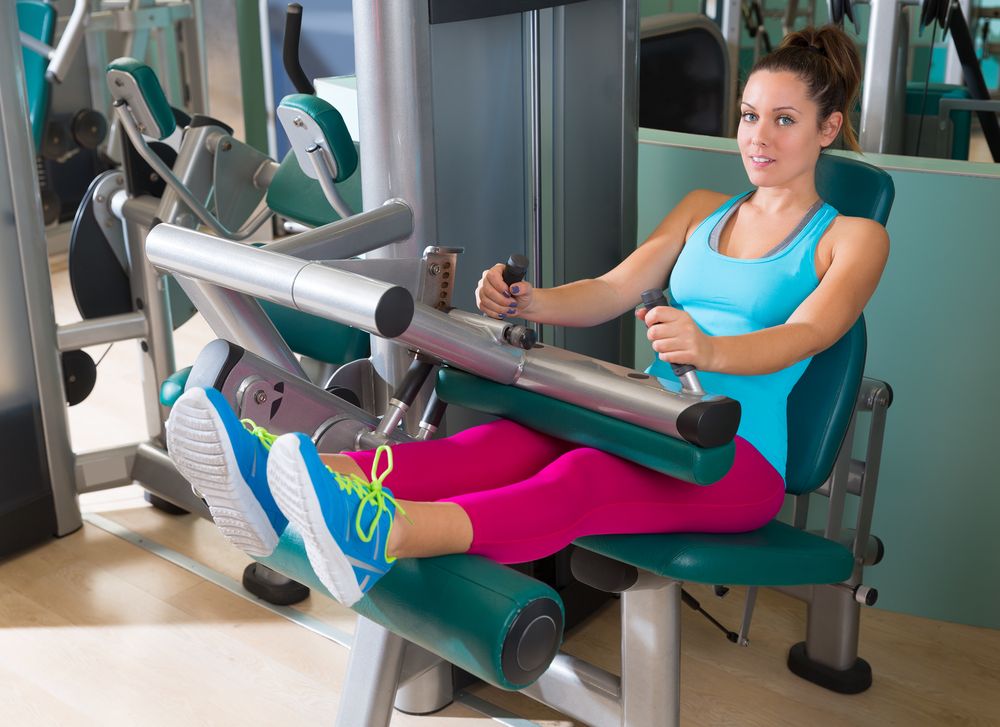
Seated leg curls are designed to target the biceps of your lower body, namely the hamstrings, effectively. Emphasize a deliberate tempo and focus on contracting your muscles firmly with each repetition to enhance leg definition.
Begin by sitting on the leg curl machine with your feet securely positioned under the foot pad. Exhale as you pull the padded lever towards your glutes, contracting your hamstrings and holding the squeeze briefly. Inhale as you gradually extend your legs back to the starting position, ensuring control throughout the movement. Aim for three sets of 12 to 15 repetitions, resting for 60 seconds between sets.
Workout #4: Full-Body HIIT (High-Intensity Interval Training)
HIIT (High-Intensity Interval Training) sparks your metabolism and elevates your heart rate, demanding sustained effort and intensity throughout the entire workout. Although free weights remain a part of this routine, it primarily focuses on dynamic exercises crafted to amplify the intensity of your training session.
1) Kettlebell High-Pull
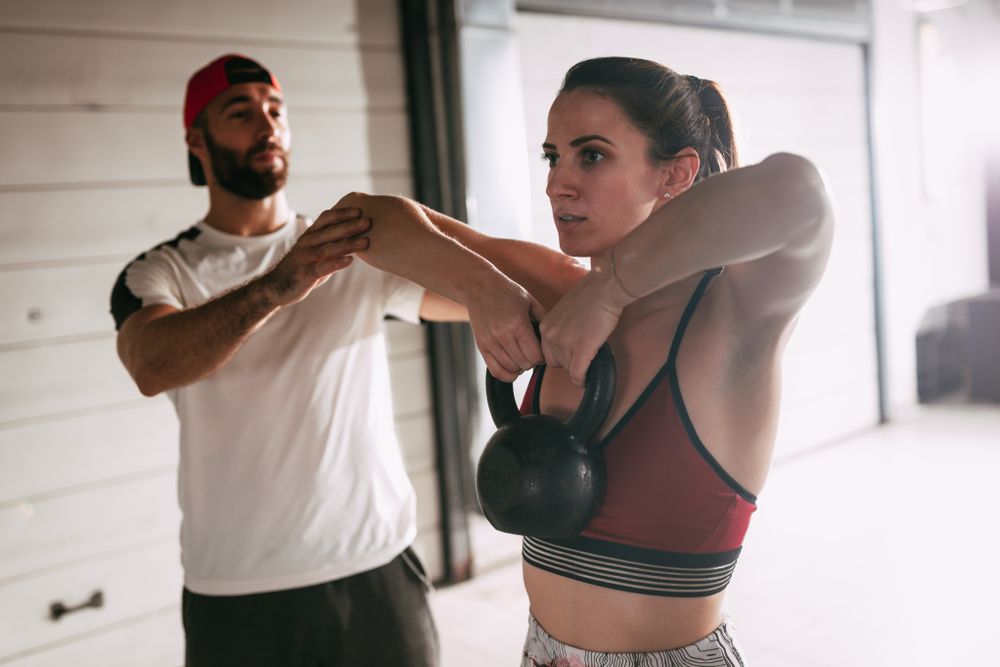
The kettlebell high-pull combines explosive leg power with a vigorous upward pull from the arms and upper back, creating a dynamic, potent, and full-body engaging exercise. It's an ideal choice for torching fat and is perfect for inclusion in a HIIT workout routine.
To perform the kettlebell high-pull, begin by standing with your feet shoulder-width apart and positioning a kettlebell between your feet. Slightly bend your knees and hinge your hips to grip the kettlebell. Utilize explosive force to push through your legs while simultaneously pulling the kettlebell towards your chest. Drive your elbows upward and outward, aiming to lift the kettlebell to chest level. Hold briefly at the peak of the movement, squeezing your shoulder blades together and maintaining a tight core. Lower the kettlebell back down in a controlled manner to the starting position. Aim to complete four to six rounds of 30 seconds with 15 seconds of rest between sets.
2) Dumbbell Push Presses
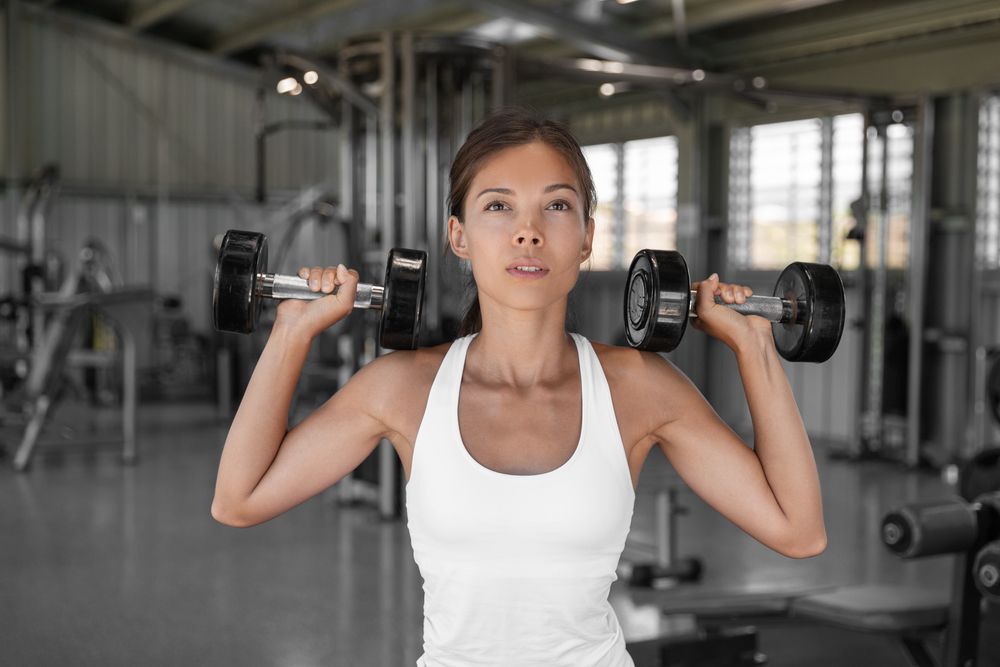
The dumbbell push press combines lower and upper-body strength, with your legs initiating the movement through an upward drive out of the dip, emphasizing the "push" phase. Your arms follow suit with force, completing the pressing action. This full-body, high-intensity exercise effectively targets and sculpts key muscle groups including the quads, glutes, shoulders, and triceps.
To perform the dumbbell push press, start by positioning yourself with feet shoulder-width apart, holding a dumbbell in each hand at shoulder height with palms facing inward. Engage your core and initiate a slight knee bend to generate momentum. Then, explosively push your legs upward, driving through your feet to propel the dumbbells overhead. Concurrently, press the dumbbells upward, extending your arms until they are straight overhead. Your legs should provide the primary force, while your arms complete the movement. Pause briefly at the top position, then lower the dumbbells back down to shoulder height with control. Aim to complete four to six rounds of 30 seconds with 15 seconds of rest between sets.
3) Medball Front Slams
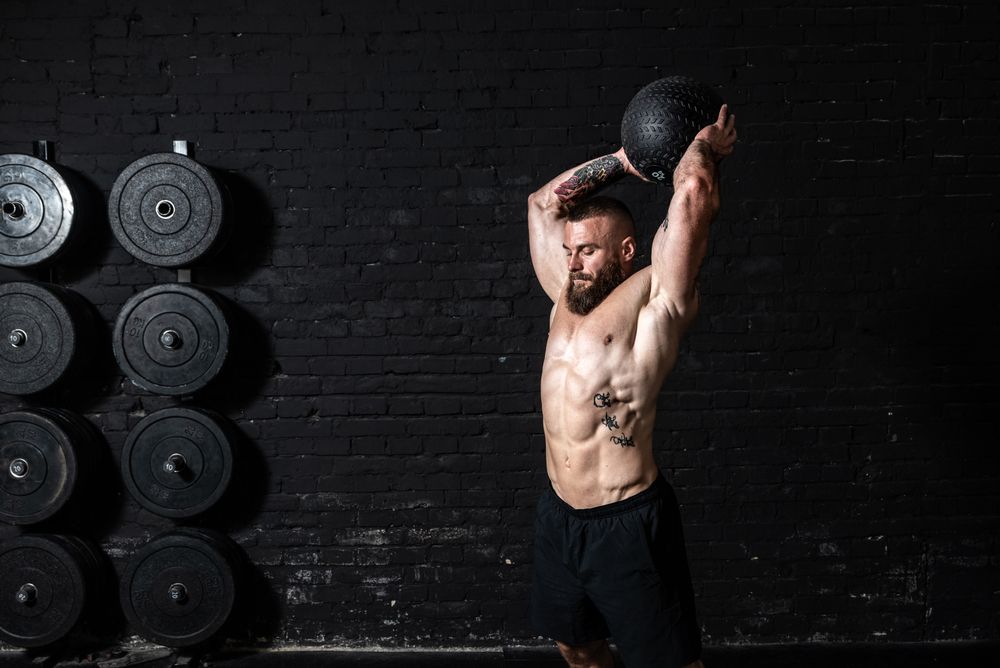
Front slams are an intense, core-engaging exercise that not only burns fat but also relieves stress. Note: Use a medicine ball that can be slammed quickly and does not bounce.
To perform front slams, begin by standing with your feet shoulder-width apart, holding a medicine ball with both hands in front of your chest. Engage your core and maintain a slight knee bend. Lift the medicine ball overhead, fully extending your arms, then forcefully slam the ball down toward the ground in front of you. Aim to target the ground directly in front of your feet. Complete four to six rounds of 30 seconds with 15 seconds of rest between sets.
Workout #5 Cardio, Cardio, Cardio!
Concluding this compilation of the top weight-loss workouts for beginners is a focus on cardio. This routine offers flexibility, allowing you to select your preferred cardio machine or activity, whether it's jogging, running, using a treadmill, ski erg, rower, or any other option available to you. I'll provide guidance on the intervals you'll undertake, enabling you to customize the workout based on your preferences and equipment accessibility. You can opt to complete each session on the same machine or switch to different equipment for each interval workout.
1) Short Intervals

Short intervals play a crucial role in boosting your anaerobic capacity, ultimately enhancing your endurance performance. These intervals consist of brief bursts of high-intensity effort followed by short rest periods. It's important to let your heart rate decrease and grant yourself a few minutes of recovery before transitioning to moderate intervals. Incorporating these intervals into your routine offers various benefits for athletes and clients, introducing diversity to typical cardio workouts, thus keeping them engaging and effective.
To execute short intervals, aim to complete five to 10 rounds of 20 seconds of higher intensity work, followed by 40 to 60 seconds of very low intensity.
2) Moderate Intervals

Moderate intervals bridge the intensity of short-effort intervals with the fat-burning potential of low-intensity steady-state workouts.
Execute eight to 12 rounds of 30 seconds of moderate-intensity work, followed by 30 seconds of low-intensity rest periods.
3) Low-Intensity Steady State
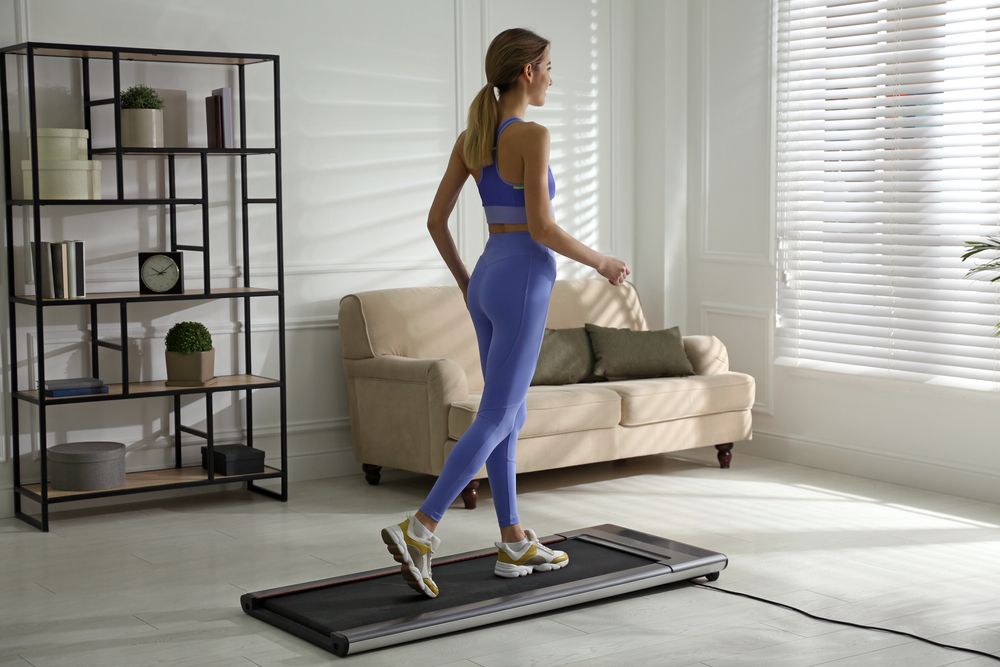
Low-intensity steady state cardio is widely recognized as one of the most effective methods for utilizing cardio to aid weight loss. The concept is simple: maintain a low to moderate intensity level throughout the duration of the workout.
To implement this, aim to complete one to two rounds of 10 to 15 minutes of low- to moderate-intensity cardio. If opting for two rounds, take a rest period of three to five minutes between each round.

